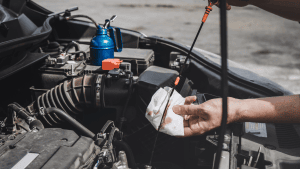Contents
- How Often Should You Check the Engine Oil Level: A Comprehensive Guide
- Understanding the Importance of Checking Engine Oil Level
- Determining the Ideal Frequency for Checking Engine Oil Level
- Factors That May Require More Frequent Oil Level Checks
- How to Check the Engine Oil Level
- When should you check engine oil level
- How often should you top up engine oil
- Should i check my oil when the engine is hot or cold
- How often should you check the engine oil level boat
- Conclusion:
- FAQs
How Often Should You Check the Engine Oil Level: A Comprehensive Guide
How often should you check the engine oil level?
Regularly checking the engine oil level is a crucial aspect of vehicle maintenance.
Adequate oil levels are essential for optimal engine performance and longevity.
In this comprehensive guide, we will discuss the recommended frequency for checking the engine oil level.
By following these guidelines, you can ensure that your engine stays properly lubricated, reducing the risk of damage and maintaining a smooth operation.
Understanding the Importance of Checking Engine Oil Level
Lubrication and Cooling:
Engine oil lubricates moving parts, reducing friction and wear.
It also helps dissipate heat, preventing the engine from overheating.
Monitoring the oil level ensures that the engine components receive proper lubrication, enhancing their lifespan and performance.
Early Detection of Issues:
Checking the engine oil level regularly allows you to detect potential problems early on.
Abnormal oil levels could indicate leaks, consumption issues, or engine malfunctions.
Identifying these issues promptly can help you address them before they lead to severe engine damage.
Determining the Ideal Frequency for Checking Engine Oil Level
Manufacturer’s Recommendations:
The best starting point for determining how often to check the engine oil level is your vehicle’s manufacturer guidelines.
Consult the owner’s manual or maintenance schedule to find the recommended interval for checking the oil level.
General Guidelines:
As a general rule of thumb, it is advisable to check the engine oil level at least once a month.
This frequency provides a good balance between regular monitoring and avoiding excessive checking.
However, keep in mind that driving conditions, climate, and the age of the vehicle can impact the frequency of oil checks.
Factors That May Require More Frequent Oil Level Checks
High Mileage or Older Vehicles:
Older vehicles or those with high mileage may require more frequent oil level checks.
These vehicles often experience increased oil consumption or leaks, necessitating closer monitoring to maintain proper oil levels.
Severe Driving Conditions:
If you frequently drive in severe conditions, such as extreme temperatures, stop-and-go traffic, or towing heavy loads, it is advisable to check the oil level more often.
These conditions can put additional strain on the engine, leading to increased oil consumption.
How to Check the Engine Oil Level
Park on Level Ground:
Ensure that your vehicle is parked on level ground before checking the oil level.
This provides an accurate reading.
Allow the Engine to Cool (If Recommended):
If your vehicle’s manufacturer recommends checking the oil level when the engine is cold, wait for a few minutes after turning off the engine before proceeding.
If there is no specific recommendation, you can check the oil level either when the engine is hot or cold.
Locate the Dipstick and Check the Level:
Open the hood and locate the engine oil dipstick.
Pull it out, wipe it clean with a cloth, reinsert it fully, and then remove it again.
Check the oil level on the dipstick.
The dipstick will have markings indicating the appropriate oil level range.
Ensure that the oil level falls within this range.
When should you check engine oil level
Checking the engine oil level is an important part of regular vehicle maintenance, and it is recommended to check the oil level regularly.
The frequency of checking the oil level can vary depending on factors such as the vehicle’s age, driving conditions, and oil consumption rate.
However, a general guideline is to check the engine oil level at least once a month.
Additionally, it is a good practice to check the oil level before long trips or after significant changes in driving conditions, such as towing a heavy load or driving in extreme temperatures.
These factors can affect oil consumption and may require more frequent checks.
To check the engine oil level, park the vehicle on a level surface and wait for the engine to cool down for a few minutes.
Locate the oil dipstick, which is usually marked with a bright-colored handle and positioned near the engine.
Remove the dipstick, wipe it clean with a cloth or paper towel, reinsert it fully, and then remove it again.
Check the oil level on the dipstick, ensuring it falls within the recommended range, which is usually indicated by two marks labeled “Min” and “Max” or by a crosshatched area.
If the oil level is below the recommended range or close to the “Min” mark, it is advisable to add oil to bring it back to the optimal level.
Use the appropriate type and viscosity of oil as specified in the vehicle’s owner’s manual.
Regularly checking the engine oil level helps ensure proper lubrication, which is crucial for the engine’s performance and longevity.
It allows early detection of any oil leaks or excessive oil consumption, which may indicate underlying issues that require attention.
By making it a habit to check the engine oil level at regular intervals, you can maintain optimal engine health and address any potential problems promptly, contributing to the overall reliability and longevity of your vehicle.
How often should you top up engine oil
The frequency of topping up engine oil depends on various factors such as the age and condition of the vehicle, driving habits, and the oil consumption rate of the engine.
While some vehicles may consume more oil than others, it is generally recommended to check the engine oil level regularly and top it up as needed to maintain it within the recommended range.
A good starting point is to check the oil level once a month, especially for vehicles with average oil consumption.
This allows you to monitor the oil level and catch any significant drops before they potentially cause engine damage.
However, if you notice that your vehicle’s engine consumes oil at a faster rate, you may need to check the oil level more frequently, such as every two weeks or even weekly.
It’s important to understand that topping up engine oil should not be seen as a solution for excessive oil consumption or oil leaks.
If you find yourself needing to top up the oil frequently, it is advisable to have the vehicle inspected by a professional mechanic.
Excessive oil consumption can indicate underlying issues such as worn piston rings, valve seals, or gaskets, which should be addressed to prevent further damage to the engine.
When topping up the engine oil, it’s crucial to use the correct type and viscosity of oil recommended by the vehicle manufacturer.
Refer to the owner’s manual or consult with a trusted mechanic to ensure you select the appropriate oil for your specific vehicle model.
To top up the oil, park the vehicle on a level surface and wait for the engine to cool down.
Locate the oil filler cap, usually labeled “Oil” or with a small oil can symbol, and remove it.
Using a funnel, add the oil slowly and carefully to avoid overfilling.
It’s recommended to add small amounts at a time, allowing the oil to settle and checking the oil level on the dipstick periodically until it reaches the recommended range.
Regularly monitoring and topping up the engine oil as needed helps maintain proper lubrication, which is essential for the engine’s performance and longevity.
It also helps ensure that the engine operates within optimal temperature ranges and reduces the risk of excessive wear and damage to critical engine components.
In summary, the frequency of topping up engine oil depends on various factors.
Checking the oil level once a month is a good starting point, but adjust the frequency based on your vehicle’s oil consumption rate.
Remember to use the recommended oil type and viscosity and address any excessive oil consumption issues promptly to prevent potential engine damage.
Should i check my oil when the engine is hot or cold
When it comes to checking the engine oil, the ideal time to do so is when the engine is warm or at operating temperature.
Checking the oil when the engine is warm provides a more accurate assessment of the oil level and condition.
Here’s a more detailed explanation:
When the engine is running, the oil circulates throughout the various components, ensuring proper lubrication and cooling.
This continuous circulation allows the oil to reach its normal operating level.
By checking the oil when the engine is warm, you get a more precise reading because the oil has had time to settle in the oil pan after circulating through the engine.
To check the oil when the engine is warm, follow these steps:
- Park the vehicle on a level surface and turn off the engine.
- Allow the engine to idle for a few minutes, which helps raise the temperature of the oil to its operating range.
Open the hood and locate the engine oil dipstick. It is usually marked with a bright-colored handle and positioned near the engine. - Carefully remove the dipstick and wipe it clean with a cloth or paper towel to remove any residual oil.
- Reinsert the dipstick fully into its tube, ensuring a tight fit.
- Remove the dipstick again and observe the oil level indicated on the dipstick.
Checking the oil when the engine is warm provides a more accurate measurement because the oil has had time to drain back into the oil pan, giving you a true indication of the oil level.
However, it is important to exercise caution as the engine components, including the dipstick and surrounding areas, may still be hot, so be mindful of the risk of burns.
On the other hand, checking the oil when the engine is completely cold, such as first thing in the morning before starting the vehicle, can lead to a falsely high reading.
This is because the oil has had ample time to settle in the oil pan, and not all of it may have returned from the engine components, giving an inaccurate impression of the oil level.
In conclusion, checking the engine oil when the engine is warm or at operating temperature provides a more accurate assessment of the oil level.
This ensures that you can make informed decisions about topping up or changing the oil based on the correct measurement.
However, always exercise caution when working with hot engine components to prevent any injuries.
By following these guidelines, you can properly monitor the engine oil and maintain optimal engine performance and longevity.
How often should you check the engine oil level boat
Checking the engine oil level in a boat is crucial for proper maintenance and smooth operation on the water.
The frequency of checking the engine oil level can vary depending on factors such as the boat’s engine type, usage patterns, and manufacturer recommendations. Here’s a detailed explanation:
As a general guideline, it is recommended to check the engine oil level in a boat before each outing or at least once a month during the boating season.
However, certain factors may require more frequent checks.
For example, if you frequently operate your boat in harsh conditions such as saltwater, extreme temperatures, or high RPM ranges, it’s advisable to check the oil level more frequently, such as every few days or every few hours of operation.
To check the engine oil level in a boat, follow these steps:
- Ensure the boat is on a level surface and the engine is turned off.
- Locate the engine’s dipstick, which is typically located near the engine block.
- Remove the dipstick and wipe it clean with a cloth or paper towel to remove any oil residue.
- Reinsert the dipstick fully into its tube, making sure it is seated securely.
- Remove the dipstick again and observe the oil level indicated on the dipstick.
When checking the oil level in a boat, it’s important to pay attention to the recommended oil level range specified by the boat manufacturer.
This range is typically marked on the dipstick itself or mentioned in the owner’s manual. Ensure that the oil level falls within this range.
If the oil level is below the minimum mark or significantly low, it is necessary to add oil to bring it up to the optimal level.
Refer to the boat’s manual or consult with a marine mechanic to determine the appropriate type and viscosity of oil to use for your specific boat’s engine.
Regularly checking the engine oil level in a boat helps ensure proper lubrication, which is vital for the engine’s performance and longevity.
It allows for early detection of any oil leaks, excessive oil consumption, or potential engine issues that may require attention.
Neglecting to check the oil level regularly can lead to engine damage, reduced performance, and potential breakdowns while out on the water.
In addition to checking the oil level, it’s also important to follow the recommended oil change intervals and other maintenance tasks outlined in the boat’s owner’s manual.
Regular maintenance, including oil changes and filter replacements, will help keep the engine in optimal condition and extend its lifespan.
By adhering to a regular schedule of checking the engine oil level in your boat and following the manufacturer’s maintenance guidelines, you can enjoy worry-free boating and ensure the longevity of your boat’s engine.
Conclusion:
Regularly checking the engine oil level is vital for maintaining the health and performance of your engine.
Following the recommended guidelines and considering factors such as vehicle age and driving conditions will help you determine the ideal frequency for checking the oil level.
By adopting a proactive approach to engine oil maintenance, you can ensure that your vehicle operates smoothly and prolong its lifespan.
FAQs
Q. How often should you check the oil level boating? A. Regularly checking the engine oil level in your boat is vital for maintaining optimal engine performance and preventing potential damage. It is recommended to check the engine oil level before each boating outing or at least once a month during the boating season. Boating conditions, such as water type, temperature, and engine usage, can impact the oil's performance and depletion rate. Checking the oil level before each outing ensures that you start with an adequate amount of oil for proper lubrication and cooling. Monthly checks are essential to monitor the oil level over time and identify any gradual drops or abnormal oil consumption. These checks allow you to catch any potential leaks or issues early on, minimizing the risk of engine damage or breakdowns while out on the water. Additionally, factors like extended idling, high RPM usage, or operating in harsh conditions such as saltwater or extreme temperatures may increase oil consumption or accelerate oil degradation. In such cases, more frequent oil level checks are recommended. By incorporating regular engine oil level checks into your boating maintenance routine, you can ensure that your boat's engine operates smoothly and reliably. It provides you with peace of mind, knowing that you are proactively monitoring one of the most critical aspects of your boat's engine health. Q. How do I know when my engine needs oil? A. There are several signs that indicate your engine may need oil. These include low oil level on the dipstick, dashboard warning lights indicating low oil pressure, engine noise such as knocking or ticking, poor engine performance, and excessive exhaust smoke. If you notice any of these signs, it's important to check the oil level and top it up if needed. Q. How often should you check the engine oil level twice each year? A. Checking the engine oil level only twice a year is not sufficient for proper maintenance. It is recommended to check the oil level more frequently, such as every few weeks or before each boating trip. Regular checks help ensure optimal lubrication and catch any significant drops in oil levels that may indicate leaks or excessive oil consumption. Q. How long should I check engine oil? A. Checking the engine oil level is a quick process that usually takes a few minutes. Start by parking the boat on a level surface and turning off the engine. Locate the dipstick, remove it, and wipe it clean. Reinsert the dipstick fully, remove it again, and observe the oil level indicated on the dipstick. Ensure the oil level falls within the recommended range.





